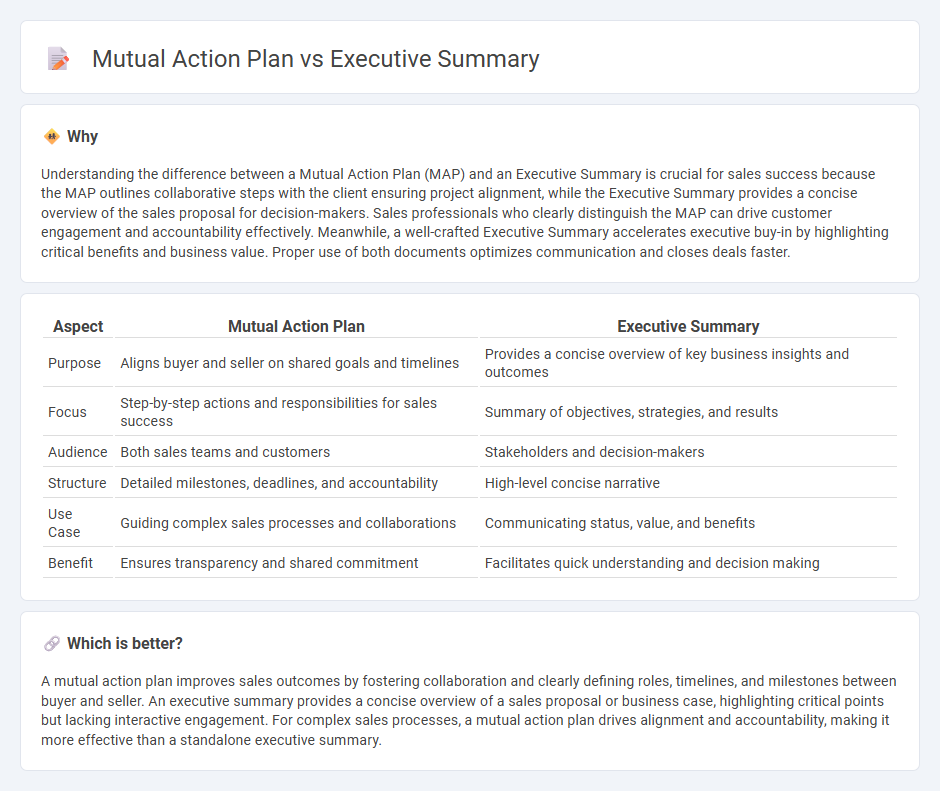
A mutual action plan outlines collaborative steps and responsibilities between a sales team and a client to ensure project success, focusing on timeline, deliverables, and accountability. An executive summary provides a concise overview of the entire sales proposal, highlighting key benefits, costs, and strategic goals for quick stakeholder review. Explore how combining these tools streamlines communication and drives sales effectiveness.
Why it is important
Understanding the difference between a Mutual Action Plan (MAP) and an Executive Summary is crucial for sales success because the MAP outlines collaborative steps with the client ensuring project alignment, while the Executive Summary provides a concise overview of the sales proposal for decision-makers. Sales professionals who clearly distinguish the MAP can drive customer engagement and accountability effectively. Meanwhile, a well-crafted Executive Summary accelerates executive buy-in by highlighting critical benefits and business value. Proper use of both documents optimizes communication and closes deals faster.
Comparison Table
| Aspect | Mutual Action Plan | Executive Summary |
|---|---|---|
| Purpose | Aligns buyer and seller on shared goals and timelines | Provides a concise overview of key business insights and outcomes |
| Focus | Step-by-step actions and responsibilities for sales success | Summary of objectives, strategies, and results |
| Audience | Both sales teams and customers | Stakeholders and decision-makers |
| Structure | Detailed milestones, deadlines, and accountability | High-level concise narrative |
| Use Case | Guiding complex sales processes and collaborations | Communicating status, value, and benefits |
| Benefit | Ensures transparency and shared commitment | Facilitates quick understanding and decision making |
Which is better?
A mutual action plan improves sales outcomes by fostering collaboration and clearly defining roles, timelines, and milestones between buyer and seller. An executive summary provides a concise overview of a sales proposal or business case, highlighting critical points but lacking interactive engagement. For complex sales processes, a mutual action plan drives alignment and accountability, making it more effective than a standalone executive summary.
Connection
A mutual action plan aligns sales teams and clients by outlining clear steps toward closing deals, ensuring transparency and accountability at each stage. The executive summary encapsulates key objectives and progress from the mutual action plan, providing stakeholders with a concise overview of sales strategy and commitments. Together, they enhance collaboration and drive successful sales outcomes by maintaining focus and clarity throughout the sales cycle.
Key Terms
**Executive Summary:**
The Executive Summary provides a concise overview of a business proposal, highlighting key points such as objectives, strategies, and expected outcomes to quickly inform stakeholders. It focuses on summarizing critical data and insights, enabling decision-makers to grasp the essence without delving into detailed plans. Discover more about how a well-crafted Executive Summary can drive better communication and project alignment.
Overview
An executive summary provides a concise overview of a document or project, highlighting key objectives, findings, and recommendations for stakeholders. A mutual action plan outlines a detailed, collaborative timeline of tasks and responsibilities agreed upon by all parties to ensure project success. Explore more to understand how these tools optimize communication and project alignment.
Key Objectives
An executive summary highlights key objectives by providing a concise overview of a project's goals, scope, and expected outcomes, emphasizing strategic alignment and decision-making priorities. A mutual action plan focuses on collaboratively defined key objectives, detailing specific tasks, timelines, and responsibilities to ensure accountability and progress tracking. Explore more to understand how aligning these tools can drive successful project execution and stakeholder engagement.
Source and External Links
Writing an Executive Summary | UAGC Writing Center - An executive summary provides an overview of a longer report's key points, restates its purpose, highlights major findings, and includes enough detail for decision-making without reading the full report, often targeted to business leaders for quick understanding.
Executive summary - Wikipedia - An executive summary is a short document or section that summarizes a longer report or proposal, presenting the problem, background, analysis, and conclusions to help managers make decisions without reading the entire document.
How to Write an Executive Summary, with Examples [2025] - Asana - This guide explains how to write an executive summary by stating the problem, outlining the solution or project objectives, explaining the solution's value, and concluding with the project's importance and next steps in a concise format.
 dowidth.com
dowidth.com